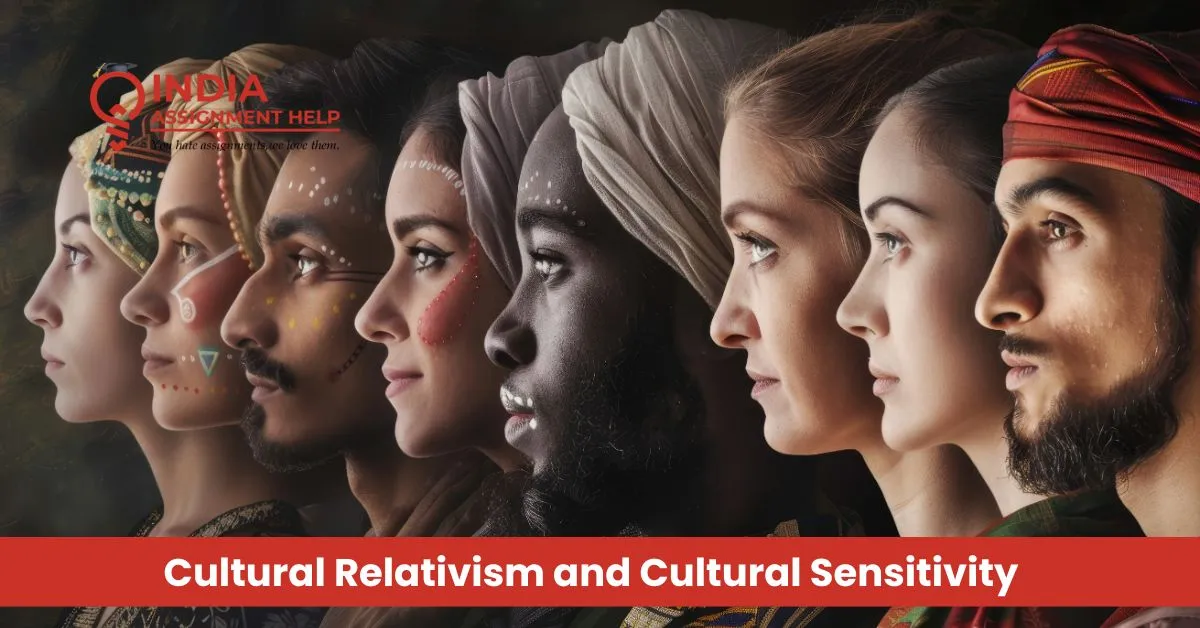Understanding Cultural Relativism and Cultural Sensitivity

In the modern world, educational environments and job settings are among the most diverse environments that gather people with different cultural backgrounds. This opens new avenues of cooperation, but it also establishes communication difficulties. Cultural awareness is something that is not only a skill but a requirement for international students in Canada. Cultural relativism and cultural sensitivity also enable students to view differences in an open-minded manner, which is both academically and socially desirable.
Cultural awareness creates stronger bonding among people. It enhances the spirit of empathy and regard towards diversity. Cross-cultural understanding is fundamental in a place like Canada, where multiculturalism is in everyday life. Students are also expected to consider the viewpoints that are different than their own traditions, either in lectures, assignments, or community relationships.
This guide examines what cultural relativism and cultural sensitivity are, why they are important, and how to apply them to academic work. The target audience is the current international students, particularly those still adapting to the diversity in Canada. Reading these sections, you may realize that the understanding of the cultural differences contributes both to personal and academic achievements. When it comes to sociology assignments or early childhood education jobs, the culturally sensitive insights will guide you through your path successfully.
Defining Cultural Relativism in a Global Context
Cultural relativism is the view that beliefs and practices must be seen within the context of a culture in which they are held. It evolved within anthropology, where anthropologists were keen to preserve the traditions without necessarily evaluating them on their own principles. Cultural relativism, in simple terms, means steering away from the notion of making quick judgments of what is right or wrong between cultures.
This understanding enables us to view cultural differences as special and distinct when there is a global society. To illustrate, festivals, rituals, or even family roles may be strange to the outside but hold a great deal of importance to their respective people. In Canada, where multiculturalism is a defining aspect, cultural relativism becomes relevant to contributing to irregularity among the various groups.
Learners are likely to learn this aspect in sociology and anthropology courses. It provokes them to think critically of moral relativism and universal values. Meanwhile, it allows them to form a balanced point of view. That does not mean that we have to agree with everything that is practiced. It does not teach them, but helps the students to understand that traditions are historically grounded and contextual.
This method can also be especially useful to international students as a way of adjusting to life in Canada. Studying in classes, communicating in a multicultural education center, participating in cultural activities, and learning with cultural relativism can make students respect differences and expand their world.
The Importance of Cultural Sensitivity in Daily Life
Cultural relativism takes it a step further and gives way to cultural sensitivity. It does not just imply knowledge but also acts in response with dignity when connecting with other cultures. In everyday activities, this is related to being able to share compassion and exercising inclusion.
Using the above as an example, in the classrooms, cultural sensitivity can be seen in the fact that students have different learning styles due to different cultural backgrounds. The Canadian universities mostly design inclusive classrooms where everyone is supposed to participate. Likewise, in the workplace, cultural sensitivity contributes to teamwork and less misunderstanding.
To international students, cultural sensitivity is the most important to feel accepted and to form new friends. It helps them adapt to Canadian culture without losing touch with their own. Sensitivity is exhibited through small gestures such as the consideration of words before their usage, adherence to dietary requirements, or even consideration of cultural holidays.
This concept is also a key concept with regard to intercultural communication. There can be a lot of misunderstandings because of the difference in tone, gestures, or assumptions. Having cultural sensitivity can fill in these gaps and facilitate the communication process.
The cultural respect in Canada is not merely toleration, but it is about providing a healthy environment where everyone feels important. Students with an education in cultural sensitivity develop skills beyond the assignments. As someone taking early childhood care and education courses or even seeking early childhood educator jobs, sensitivity is a professional asset. In short, cultural sensitivity enriches academic, as well as social experiences, and makes them more inclusive and significant.
Cultural Relativism vs. Cultural Sensitivity: Key Differences
Though related, cultural relativism and cultural sensitivity are not the same. Relativism is about understanding practices within their cultural context. Sensitivity is about how we respond to those practices in daily interactions.
Here’s a breakdown:
- Cultural Relativism: A theoretical concept. It asks us to suspend judgment and see cultural differences as valid within their context.
- Cultural Sensitivity: A practical behavior. It involves respect, empathy, and adaptation when engaging with people from different cultures.
The contrast is precisely in action. Cultural relativism can assist the students in developing a critical attitude toward traditions and cultural adaptation. Cultural sensitivity means that they communicate and behave respectfully.
The difference is applicable in diversity studies. Tolerance without acceptance may create a distance, and sensitivity will bring a sense of trust and inclusivity. International students capable of not only grasping the concepts but also comprehending them can excel both academically and socially. No matter how many writing tasks one can complete or how many multicultural events one can attend, being aware of when it is necessary to use relativism and when it is better to be sensitive makes a huge difference in the results.
Academic Relevance: Why Students Study These Concepts
Cultural relativism and cultural sensitivity are predominant themes in sociology, anthropology, and education classes. Canadian universities focus on these issues as they mirror the world in terms of diversity.
Assignments on these concepts incite students to use critical thinking and academic writing abilities. As a particular example, the sociology assignments can require students to analyze the cultural differences without bias. Anthropology essays could be on traditions within societies. The context of cultural relativism is what will help explain this kind of work.
The professional development is also directly related to cultural sensitivity. Students in online early childhood education degree programs or practicing in an early childhood education center have to be aware of cultural differences as part of their daily responsibility. Sometimes the children and families would have different backgrounds, thus sensitivity should be used to maintain fairness and inclusivity.
Academic research is also helpful. Through cultural relativism, students are taught to understand how to study ethical viewpoints without making generalizations. They learn to be culturally sensitive, enabling them to communicate and present ideas better.
Practical Applications in Canadian Society
Cultural relativism and sensitivity are not limited to academic theory. They are applied daily across Canadian society.
In workplaces, diversity programs encourage employees to understand and adapt to cultural differences. This reduces conflict and strengthens collaboration. In schools, multicultural education ensures that all children feel included, regardless of background. International students see this firsthand when they join inclusive classrooms or awareness programs.
Immigrant integration is another area where these concepts matter. Communities that practice cultural sensitivity create social harmony and help newcomers feel at home. Canadian culture embraces this diversity, making it easier for students to connect with peers, mentors, and future employers.
For international students, these examples highlight how academic concepts translate into real-world benefits. By observing and practicing them, students gain confidence in navigating life in Canada.
Challenges and Criticism of Cultural Relativism
Cultural relativism can be accepted as encouraging understanding, but there are drawbacks. A frequent objection to it is that it can justify bad practices. As an example, it means that everything is culturally valid, and there is little chance of questioning human rights violations.
The most common ethical discussions are related to this matter. Are destructive cultures supposed to #8216 strictest traditions that we are to live by? Critics respond that judgment still needs to be driven by universal values, which include equality and dignity. Advocating relativism without boundaries will bring about war instead of peace among cultures.
Students ought to know about these arguments. In assignments, professors usually require a balanced view to be taken. This is an element of critical thinking presented in that, although one can appreciate the strengths of relativism, it is also vital to identify its shortcomings.
International students in Canada are likely to be put into these dilemmas whenever facing practices contrary to his or her values. By examining criticisms, they get to understand how to be respectful to diversity as well as promote universal human rights. This moderate practice reinforces statements of academics combined with self-development.
Building Cultural Sensitivity in Education and Work
Culture awareness is a thing that can be trained. In education, it begins with inclusive classes. Teachers employ ideas such as group work and open discussion to make sure that every voice is heard. In students, this creates confidence and belongingness.
Exchange programs between students also make people sensitive. Studying abroad and experiencing another culture helps students understand and learn compassion and awareness. Canadian universities promote such activities in order to increase the horizons.
Cultural sensitivity training in the workplace helps shift an employee to the new culture of the Canadian workplace. Awareness programs are aimed at communication, teamwork, and welcome. International students who plan to work in the field of early childhood education can use these skills too. Child and family supports need patience, understanding, and respect for diversity.
The process of becoming sensitive is not perfect, but sensitive to learning. By learning to practice empathy in everyday activities, such as in classrooms, part-time employment, and in social gatherings, the students will build better relationships and succeed in their careers.
Conclusion: The Role of Cultural Understanding in Academic Success
Cultural relativism and cultural sensitivity are not just ideas of theory. They define the way students study, interact, and achieve success in Canada. Students embrace diversity and positively advance academically, and are prepared to enter professions in the future.
Assignments that are aimed at discussing these thoughts promote critical thinking. Through cultural learning skills, students enhance their writing skills and their research capabilities. Other than academic work, understanding cultural diversity develops global thinking, which never fades in life.
International students can get the feeling of being overwhelmed, but with cultural understanding, it is an avenue to follow. It can make them ready to work with teachers in Canadian classrooms, engage with peers, and work in a professional capacity. Cultural awareness is a key aspect of education training in early childhood when pursuing certification or a degree online.
Concisely, cultural relativism and cultural sensitivity breed avenues to individual and academic prosperity. By using them in research and in their daily lives, the student not only excel in their assignments but also make their contribution to Canadian society.
FAQs
Q1. How do cultural relativism and cultural sensitivity differ?
Ans. Cultural relativism is about understanding practices in context, while cultural sensitivity is about responding with respect in daily interactions.
Q2. Why are these concepts important for students in Canada?
Ans. They help students succeed academically, adjust socially, and prepare for professional roles in a multicultural environment.
Q3. How do these ideas apply to early childhood education?
Ans. Teachers and professionals use cultural sensitivity to create inclusive classrooms and care settings for children from diverse families.
Q4. Can cultural relativism be harmful?
Ans. Yes, if taken too far, it may excuse harmful practices. That is why it must be balanced with universal values like equality and human rights.
Q5. How can students build cultural sensitivity?
Ans. By practicing empathy, engaging in diverse group work, joining cultural programs, and learning from daily interactions with people from different backgrounds.





